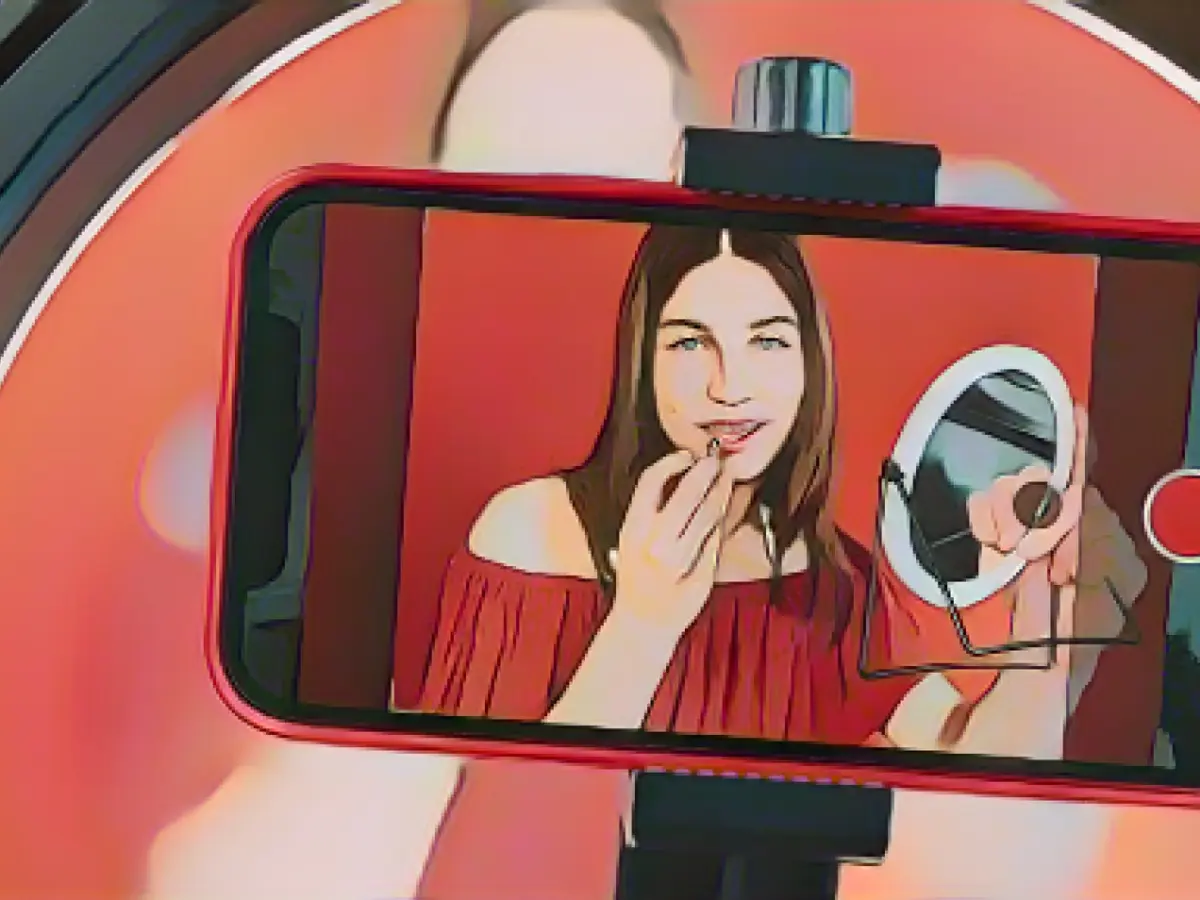TikTok - From "Tomato Girls" to "Old Money": Why microtrends are so popular with Generation Z
The fashion of the early 2000s is back. Generation Z in particular is flaunting itself on social media in colorful, flashy "Y2K" outfits. Followers of the "old money" style, on the other hand, wear restrained but luxurious clothing. The "Tomato Girls" could be found wearing frilly blouses and red lips in Italy in the 1950s, while the "Coastal Cowgirls" danced on the Californian beach in western boots. Those who wear the "Dark Academia" aesthetic prefer to sit in dark colors in the library of an elite university. "Cottagecore" followers, on the other hand, would prefer to spend their days in dresses or dungarees in a flower meadow or in the garden at home.
TikTok has accelerated the development of trends
All these fashion trends, which are mainly celebrated on TikTok, are extremely individualized, often contradictory - and very short-lived. New styles appear on the social network almost weekly. With the addition of "-core", "-aesthetic" or "-girl", a suitable hashtag is created that can collect millions of clicks within a few days. The corresponding videos show what the respective trend should look like: outfits, fashion tips, make-up tutorials, mood boards with matching accessories and - particularly frequently - clips of places, films, activities and music that are supposed to match the style. This is because the trends are not just limited to appearance, but aim to present a coherent overall picture, a complete lifestyle.
"There used to be a gothic scene and a punk scene, but very few people were members of one. Today, it's normal to belong to at least one community," explains Nina Kolleck in an interview with stern. The professor of educational and socialization theories at the University of Potsdam conducts research into Generation Z and social media, among other things. Today's fashion trends have not only become more diverse, but also more differentiated. TikTok plays a key role in this: the video platform has "revolutionized the landscape of trend development," says Stefan Tewes, trend researcher and director of the Zukunftsinstitut.
Microtrends are particularly popular with Generation Z
"TikTok is characterized by its ability to make trends go viral at lightning speed," the scientist explains to stern magazine. A single video can spread a completely new style in just a few hours. In particular, when influencers with a large following pick up on a trend, "this can increase its popularity exponentially". However, just as quickly as certain movements gain popularity, they also disappear from the scene again. Because of their short shelf life, the styles popularized on TikTok are referred to as microtrends. These are "short-lived currents or developments within a larger trend", explains Stefan Tewes.
The fleeting trends are supported above all by Generation Z, says Nina Kolleck. Young people categorize themselves according to the currently acclaimed aesthetic based on the clothing, interior design and lifestyle they display on TikTok. They proudly show off their respective scene style and share their trendy self-presentation with thousands of like-minded people all over the world. The community factor is one of the attractions that makes micro-trends so appealing to Generation Z. It's about self-discovery, explains the educationalist: young people want to feel affirmed in their personality - a feeling that is conveyed primarily through association and community.
Microtrends become part of identity - and a place of refuge
In a phase of life that is characterized by the search for belonging and the desire to set oneself apart from the older generation, microtrends "offer young people a platform for self-expression and finding their identity," confirms Stefan Tewes. The short-lived fashion trends are perfect for playing with different styles and identities: Through platforms such as TikTok, both influencers and the masses can react immediately to newly emerging aesthetics "and integrate them into their personal identity formation," explains the futurologist.
In addition, microtrends can also be seen as a reaction to social changes. As a stylistic device to signal opinions and attitudes on current topics. For the young audience, microtrends are not just a fashionable or cultural trend, "but rather a means of self-discovery and communication in a constantly changing world," the expert sums up.
However, microtrends can also be a place of refuge, says Nina Kolleck: "The short videos offer an escape that protects them from the challenges of everyday life." The many crises - climate change, corona, wars - that accompany the coming of age of Generation Z are fueling a longing for more peaceful times. No wonder that nostalgia and the supposedly simpler life (in the country, in their own four walls, in financial abundance) are recurring motifs in almost all micro-trends.
Fashion trends that go beyond beauty ideals
No one can predict which microtrend will develop into the next hype. The only certainty is that it won't last long. The constant change of trends can lead to a fluid understanding of the self, says Stefan Tewes. Adapting to this rhythm "can bring both advantages in the form of cognitive flexibility and challenges in the form of uncertainty," explains the trend researcher. Nina Kolleck is investigating the advantages and disadvantages of this.
The scientist emphasizes the diversity of fashion trends as a particularly positive aspect: "Micro-trends are not one-dimensional, but encompass many facets." This can benefit personal creativity and self-esteem, "because the young generation can express themselves and are encouraged to do so by the community". The body types depicted are also diverse: the people who appear in the TikTok videos often do not conform to the usual ideals of beauty. "This allows young people who have certain body characteristics - who feel too fat, too big, too small - to also find validation."
Microtrends can put young people under pressure
However, the effect can also be negative. According to Nina Kolleck, microtrends can also mean pressure, "a kind of pressure to conform to what is portrayed there". Even if the scenes staged on social media often do not correspond to reality: "This romanticized country life in particular has little to do with actual rural life."
Her research also shows that young people who spend a lot of time on TikTok compare themselves more often, which in turn reduces their self-esteem: "People who constantly compare themselves don't feel valuable enough and are more likely to put themselves under pressure to look like someone else." This can have an impact on eating habits, for example. Those who don't follow a trend can also feel excluded - another damper on self-esteem, says futurologist Stefan Tewes.
As important as micro-trends may be for self-discovery, the TikTok videos and mood boards are limited to appearance alone. The focus is on an identity that concentrates on outward appearance. An identity that results from certain trends rather than inner values, says Nina Kolleck.
Why the pressure to belong is so great
The search for the right label; for the right community; for the right lifestyle can feel almost endless due to the constant spiral of TikTok trends - and can become a burden under certain circumstances. The pressure to define oneself to the outside world as part of a group is extremely high within Gen Z, explains the educationalist. This is due to the enormous insecurity that characterizes young people: "This generation is one of the glaring losers of the coronavirus era."
Generation Z had little contact with the real world, nature and social relationships outside of the internet during the pandemic. This has left its mark: "Young people have lost access to their own bodies and feelings as a result." This has resulted in a profound sense of insecurity, which can be partially cushioned by microtrends. After all, the sense of community that the individual subcultures suggest can restore some of the lost security.
Read also:
- Unanimous decision: faster wolf culls possible
- No Christmas peace with the British royals
- No Christmas peace with the British royals
- No Christmas peace with the royals
- The "Dark Academia" aesthetic, which involves dressing in dark colors and spending time in library settings of elite universities, is another popular microtrend on TikTok that originated from the platform.
- At the University of Potsdam, Professor Nina Kolleck, an expert in educational and socialization theories, conducts research on Generation Z and social media, focusing on the impact of TikTok on fashion trends and how they affect self-expression and identity formation among young people.
- In the world of fashion, microtrends, like the "Cottagecore" style which involves dressing in dresses or dungarees and spending time in flower meadows or gardens, are gaining popularity among young adults, particularly on TikTok, and are often driven by influencers and community needs for self-discovery and affirmation.
Source: www.stern.de







